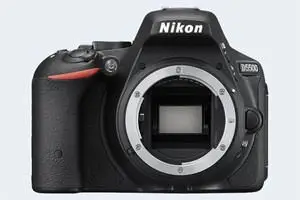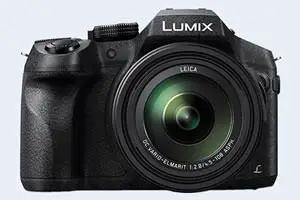Nikon D5500 vs Panasonic FZ330
The Nikon D5500 and the Panasonic Lumix DMC-FZ330 (labelled Panasonic FZ300 in some countries) are two digital cameras that were revealed to the public, respectively, in January 2015 and July 2015. The D5500 is a DSLR, while the FZ330 is a fixed lens compact. The cameras are based on an APS-C (D5500) and a 1/2.3-inch (FZ330) sensor. The Nikon has a resolution of 24 megapixels, whereas the Panasonic provides 12 MP.
Below is an overview of the main specs of the two cameras as a starting point for the comparison.

Check D5500 offers at
ebay.com

Check FZ330 price at
amazon.com
Going beyond this snapshot of core features and characteristics, what are the differences between the Nikon D5500 and the Panasonic Lumix DMC-FZ330? Which one should you buy? Read on to find out how these two cameras compare with respect to their body size, their imaging sensors, their shooting features, their input-output connections, and their reception by expert reviewers.
Body comparison
The side-by-side display below illustrates the physical size and weight of the Nikon D5500 and the Panasonic FZ330. The two cameras are presented according to their relative size. Three successive views from the front, the top, and the rear are shown. All size dimensions are rounded to the nearest millimeter.
The D5500 can be obtained in two different colors (black, red), while the FZ330 is only available in black.
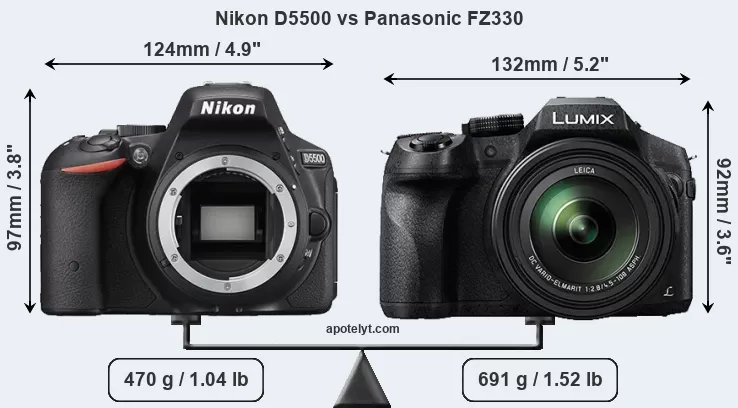
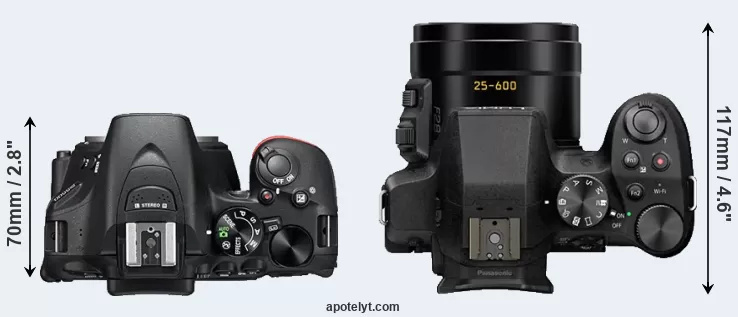
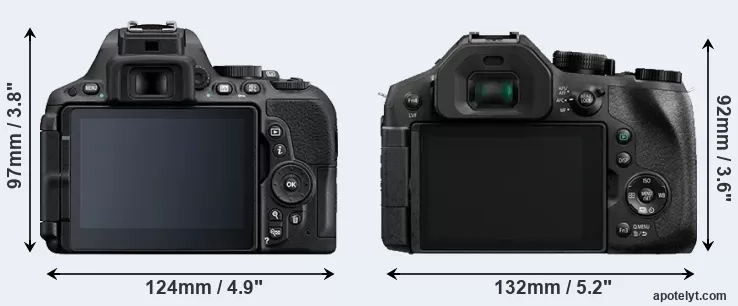
If the front view area (width x height) of the cameras is taken as an aggregate measure of their size, the Nikon D5500 and the Panasonic FZ330 are of equal size. It is noteworthy in this context that the FZ330 is splash and dust-proof, while the D5500 does not feature any corresponding weather-sealing.
The above size and weight comparisons are to some extent incomplete and possibly misleading, as the FZ330 has a lens built in, whereas the D5500 is an interchangeable lens camera that requires a separate lens. Attaching the latter will add extra weight and bulk to the setup. You can compare the optics available for the D5500 and their specifications in the Nikon Lens Catalog.
Concerning battery life, the D5500 gets 820 shots out of its Nikon EN-EL14a battery, while the FZ330 can take 380 images on a single charge of its Panasonic DMW-BLC12 power pack.
The following table provides a synthesis of the main physical specifications of the two cameras and other similar ones. In case you want to display and compare another camera duo, you can use the CAM-parator app to select your camera combination among a large number of options.

| # | Camera Model |
Camera Width |
Camera Height |
Camera Depth |
Camera Weight |
Battery Life |
Weather Sealing |
Camera Launch |
Launch Price (USD) |
Street Price |
|
|---|---|---|---|---|---|---|---|---|---|---|---|
| 1. | Nikon D5500 | 124 mm | 97 mm | 70 mm | 470 g | 820 | n | Jan 2015 | 899 | ebay.com | |
| 2. | Panasonic FZ330 | 132 mm | 92 mm | 117 mm | 691 g | 380 | Y | Jul 2015 | 599 | amazon.com | |
| 3. | Canon M5 | 116 mm | 89 mm | 61 mm | 427 g | 295 | n | Sep 2016 | 979 | ebay.com | |
| 4. | Canon G3 X | 123 mm | 77 mm | 105 mm | 733 g | 300 | Y | Jun 2015 | 999 | ebay.com | |
| 5. | Canon SX60 | 128 mm | 93 mm | 114 mm | 650 g | 340 | n | Sep 2014 | 549 | ebay.com | |
| 6. | Nikon D5600 | 124 mm | 97 mm | 70 mm | 465 g | 970 | n | Nov 2016 | 699 | ebay.com | |
| 7. | Nikon D500 | 147 mm | 115 mm | 81 mm | 860 g | 1240 | Y | Jan 2016 | 1,999 | ebay.com | |
| 8. | Nikon D3400 | 124 mm | 98 mm | 76 mm | 445 g | 1200 | n | Aug 2016 | 499 | ebay.com | |
| 9. | Nikon D3300 | 124 mm | 98 mm | 76 mm | 430 g | 700 | n | Jan 2014 | 499 | ebay.com | |
| 10. | Nikon D5300 | 125 mm | 98 mm | 76 mm | 480 g | 600 | n | Oct 2013 | 799 | ebay.com | |
| 11. | Nikon D3200 | 125 mm | 96 mm | 77 mm | 505 g | 540 | n | Apr 2012 | 599 | ebay.com | |
| 12. | Nikon D5200 | 129 mm | 98 mm | 78 mm | 555 g | 500 | n | Nov 2012 | 749 | ebay.com | |
| 13. | Nikon D5100 | 128 mm | 97 mm | 79 mm | 560 g | 660 | n | Apr 2011 | 749 | ebay.com | |
| 14. | Panasonic FZ200 | 125 mm | 87 mm | 110 mm | 588 g | 540 | n | Jul 2012 | 599 | ebay.com | |
| 15. | Panasonic FZ150 | 124 mm | 82 mm | 92 mm | 528 g | 410 | n | Aug 2011 | 499 | ebay.com | |
| 16. | Panasonic LX5 | 110 mm | 65 mm | 43 mm | 271 g | 400 | n | Jul 2010 | 499 | ebay.com | |
| 17. | Samsung NX30 | 127 mm | 96 mm | 58 mm | 375 g | 360 | n | Jan 2014 | 999 | ebay.com | |
| Note: Measurements and pricing do not include easily detachable parts, such as add-on or interchangeable lenses or optional viewfinders. | |||||||||||
The price is, of course, an important factor in any camera decision. The manufacturer’s suggested retail prices give an idea on the placement of the camera in the maker’s lineup and the broader market. The FZ330 was launched at a lower price than the D5500, despite having a lens built in. Usually, retail prices stay at first close to the launch price, but after several months, discounts become available. Later in the product cycle and, in particular, when the replacement model is about to appear, further discounting and stock clearance sales often push the camera price considerably down.
Sensor comparison
The size of the sensor inside a digital camera is one of the key determinants of image quality. A large sensor will tend to have larger individual pixels that provide better low-light sensitivity, wider dynamic range, and richer color-depth than smaller pixel-units in a sensor of the same technological generation. Moreover, a large sensor camera will give the photographer more control over depth-of-field in the image and, thus, the ability to better isolate a subject from the background. On the downside, larger sensors are more costly to manufacture and tend to lead to bigger and heavier cameras and lenses.
Of the two cameras under consideration, the Nikon D5500 features an APS-C sensor and the Panasonic FZ330 a 1/2.3-inch sensor. The sensor area in the FZ330 is 92 percent smaller. As a result of these sensor size differences, the cameras have a format factor of, respectively, 1.5 and 5.6. The sensor in the D5500 has a native 3:2 aspect ratio, while the one in the FZ330 offers a 4:3 aspect.
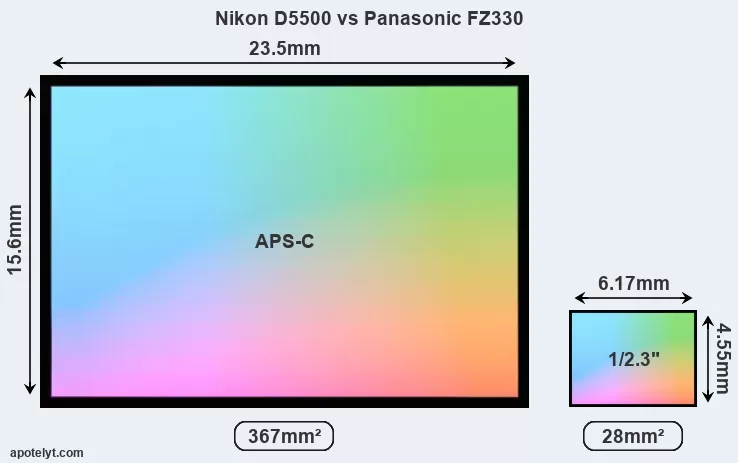
With 24MP, the D5500 offers a higher resolution than the FZ330 (12MP), but the D5500 nevertheless has larger individual pixels (pixel pitch of 3.91μm versus 1.53μm for the FZ330) due to its larger sensor. However, the FZ330 is a somewhat more recent model (by 6 months) than the D5500, and its sensor might have benefitted from technological advances during this time that enhance the light gathering capacity of its pixels. Coming back to sensor resolution, it should be mentioned that neither of the two cameras has an anti-alias filter installed, so they are able to capture all the detail the sensor resolves.
The resolution advantage of the Nikon D5500 implies greater flexibility for cropping images or the possibility to print larger pictures. The maximum print size of the D5500 for good quality output (200 dots per inch) amounts to 30 x 20 inches or 76.2 x 50.8 cm, for very good quality (250 dpi) 24 x 16 inches or 61 x 40.6 cm, and for excellent quality (300 dpi) 20 x 13.3 inches or 50.8 x 33.9 cm. The corresponding values for the Panasonic FZ330 are 20 x 15 inches or 50.8 x 38.1 cm for good quality, 16 x 12 inches or 40.6 x 30.5 cm for very good quality, and 13.3 x 10 inches or 33.9 x 25.4 cm for excellent quality prints.
The Nikon D5500 has a native sensitivity range from ISO 100 to ISO 25600. The corresponding ISO settings for the Panasonic Lumix DMC-FZ330 are ISO 100 to ISO 6400 (no boost).
In terms of underlying technology, the D5500 is build around a CMOS sensor, while the FZ330 uses a BSI-CMOS imager. Both cameras use a Bayer filter for capturing RGB colors on a square grid of photosensors. This arrangement is found in most digital cameras.
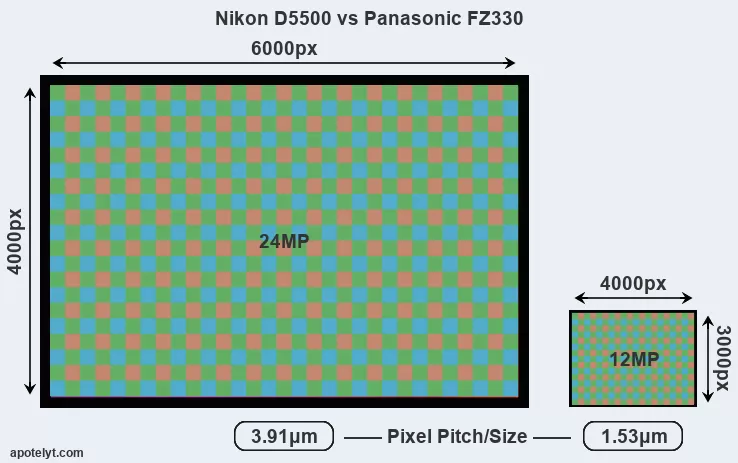
Consistent information on actual sensor performance is available from DXO Mark for many cameras. This service is based on lab testing and assigns an overall score to each camera sensor, as well as ratings for dynamic range ("DXO Landscape"), color depth ("DXO Portrait"), and low-light sensitivity ("DXO Sports"). Of the two cameras under review, the D5500 provides substantially higher image quality than the FZ330, with an overall score that is 46 points higher. This advantage is based on 4.8 bits higher color depth, 3 EV in additional dynamic range, and 3.9 stops in additional low light sensitivity. The table below summarizes the physical sensor characteristics and sensor quality findings and compares them across a set of similar cameras.

| # | Camera Model |
Sensor Class |
Resolution (MP) |
Horiz. Pixels |
Vert. Pixels |
Video Format |
DXO Portrait |
DXO Landscape |
DXO Sports |
DXO Overall |
|
|---|---|---|---|---|---|---|---|---|---|---|---|
| 1. | Nikon D5500 | APS-C | 24.0 | 6000 | 4000 | 1080/60p | 24.1 | 14.0 | 1438 | 84 | |
| 2. | Panasonic FZ330 | 1/2.3 | 12.0 | 4000 | 3000 | 4K/30p | 19.3 | 11.0 | 97 | 38 | |
| 3. | Canon M5 | APS-C | 24.0 | 6000 | 4000 | 1080/60p | 23.4 | 12.4 | 1262 | 77 | |
| 4. | Canon G3 X | 1-inch | 20.0 | 5472 | 3648 | 1080/60p | 21.4 | 12.3 | 521 | 63 | |
| 5. | Canon SX60 | 1/2.3 | 14.2 | 4608 | 3072 | 1080/60p | 19.2 | 10.8 | 127 | 39 | |
| 6. | Nikon D5600 | APS-C | 24.0 | 6000 | 4000 | 1080/60p | 24.1 | 14.0 | 1306 | 84 | |
| 7. | Nikon D500 | APS-C | 20.7 | 5568 | 3712 | 4K/30p | 24.0 | 14.0 | 1324 | 83 | |
| 8. | Nikon D3400 | APS-C | 24.0 | 6000 | 4000 | 1080/60p | 24.8 | 13.9 | 1192 | 86 | |
| 9. | Nikon D3300 | APS-C | 24.0 | 6000 | 4000 | 1080/60p | 24.3 | 12.8 | 1385 | 82 | |
| 10. | Nikon D5300 | APS-C | 24.0 | 6000 | 4000 | 1080/60p | 24.0 | 13.9 | 1338 | 83 | |
| 11. | Nikon D3200 | APS-C | 24.1 | 6016 | 4000 | 1080/30p | 24.1 | 13.2 | 1131 | 81 | |
| 12. | Nikon D5200 | APS-C | 24.0 | 6000 | 4000 | 1080/60i | 24.2 | 13.9 | 1284 | 84 | |
| 13. | Nikon D5100 | APS-C | 16.1 | 4928 | 3264 | 1080/30p | 23.5 | 13.6 | 1183 | 80 | |
| 14. | Panasonic FZ200 | 1/2.3 | 12.0 | 4000 | 3000 | 1080/60p | 19.1 | 10.8 | 114 | 37 | |
| 15. | Panasonic FZ150 | 1/2.3 | 12.0 | 4000 | 3000 | 1080/60p | 19.4 | 10.9 | 132 | 40 | |
| 16. | Panasonic LX5 | 1/1.7 | 10.0 | 3648 | 2736 | 720/60p | 19.6 | 10.8 | 132 | 41 | |
| 17. | Samsung NX30 | APS-C | 20.0 | 5472 | 3648 | 1080/60p | 23.5 | 12.4 | 1014 | 76 |
Many modern cameras are not only capable of taking still images, but also of capturing video footage. The two cameras under consideration both have sensors whose read-out speed is fast enough to capture moving pictures, but the FZ330 provides a better video resolution than the D5500. It can shoot movie footage at 4K/30p, while the Nikon is limited to 1080/60p.
Feature comparison
Apart from body and sensor, cameras can and do differ across a variety of features. For example, the FZ330 has an electronic viewfinder (1440k dots), while the D5500 has an optical one. Both systems have their advantages, with the electronic viewfinder making it possible to project supplementary shooting information into the framing view, whereas the optical viewfinder offers lag-free viewing and a very clear framing image. The viewfinder in the FZ330 offers a wider field of view (100%) than the one in the D5500 (95%), so that a larger proportion of the captured image is visible in the finder. In addition, the viewfinder of the FZ330 has a higher magnification (0.70x vs 0.57x), so that the size of the image transmitted appears closer to the size seen with the naked human eye. The adjacent table lists some of the other core features of the Nikon D5500 and Panasonic FZ330 along with similar information for a selection of comparators.

| # | Camera Model |
Viewfinder (Type or 000 dots) |
Control Panel (yes/no) |
LCD Specifications (inch/000 dots) |
LCD Attach- ment |
Touch Screen (yes/no) |
Max Shutter Speed * |
Max Shutter Flaps * |
Built-in Flash (yes/no) |
Built-in Image Stab |
|
|---|---|---|---|---|---|---|---|---|---|---|---|
| 1. | Nikon D5500 | optical | n | 3.2 / 1037 | swivel | Y | 1/4000s | 5.0/s | Y | n | |
| 2. | Panasonic FZ330 | 1440 | n | 3.0 / 1040 | swivel | Y | 1/4000s | 12.0/s | Y | Y | |
| 3. | Canon M5 | 2360 | n | 3.2 / 1620 | tilting | Y | 1/4000s | 9.0/s | Y | n | |
| 4. | Canon G3 X | optional | n | 3.2 / 1620 | tilting | Y | 1/2000s | 5.9/s | Y | Y | |
| 5. | Canon SX60 | 922 | n | 3.0 / 922 | swivel | n | 1/2000s | 6.4/s | Y | Y | |
| 6. | Nikon D5600 | optical | n | 3.2 / 1037 | swivel | Y | 1/4000s | 5.0/s | Y | n | |
| 7. | Nikon D500 | optical | Y | 3.2 / 2359 | tilting | Y | 1/8000s | 10.0/s | n | n | |
| 8. | Nikon D3400 | optical | n | 3.0 / 921 | fixed | n | 1/4000s | 5.0/s | Y | n | |
| 9. | Nikon D3300 | optical | n | 3.0 / 921 | fixed | n | 1/4000s | 5.0/s | Y | n | |
| 10. | Nikon D5300 | optical | n | 3.2 / 1037 | swivel | n | 1/4000s | 5.0/s | Y | n | |
| 11. | Nikon D3200 | optical | n | 3.0 / 921 | fixed | n | 1/4000s | 4.0/s | Y | n | |
| 12. | Nikon D5200 | optical | n | 3.0 / 921 | swivel | n | 1/4000s | 5.0/s | Y | n | |
| 13. | Nikon D5100 | optical | n | 3.0 / 921 | swivel | n | 1/4000s | 4.0/s | Y | n | |
| 14. | Panasonic FZ200 | 1312 | n | 3.0 / 460 | swivel | n | 1/4000s | 12.0/s | Y | Y | |
| 15. | Panasonic FZ150 | 202 | n | 3.0 / 460 | swivel | n | 1/2000s | 12.0/s | Y | Y | |
| 16. | Panasonic LX5 | optional | n | 3.0 / 460 | fixed | n | 1/4000s | 2.5/s | Y | Y | |
| 17. | Samsung NX30 | 2359 | n | 3.0 / 1036 | swivel | Y | 1/8000s | 9.0/s | Y | n | |
| Note: *) Information refers to the mechanical shutter, unless the camera only has an electronic one. | |||||||||||
The reported shutter speed information refers to the use of the mechanical shutter. Yet, some cameras only have an electronic shutter, while others have an electronic shutter in addition to a mechanical one. In fact, the FZ330 is one of those camera that have an additional electronic shutter, which makes completely silent shooting possible. However, this mode is less suitable for photographing moving objects (risk of rolling shutter) or shooting under artificial light sources (risk of flickering).
The Nikon D5500 and the Panasonic FZ330 both have an intervalometer built-in. This enables the photographer to capture time lapse sequences, such as flower blooming, a sunset or moon rise, without purchasing an external camera trigger and related software.
Concerning the storage of imaging data, both the D5500 and the FZ330 write their files to SDXC cards. Both cameras can use UHS-I cards, which provide for Ultra High Speed data transfer of up to 104 MB/s.
Connectivity comparison
For some imaging applications, the extent to which a camera can communicate with its environment can be an important aspect in the camera decision process. The table below provides an overview of the connectivity of the Nikon D5500 and Panasonic Lumix DMC-FZ330 and, in particular, the interfaces the cameras (and selected comparators) provide for accessory control and data transfer.

| # | Camera Model |
Hotshoe Port |
Internal Mic / Speaker |
Microphone Port |
Headphone Port |
HDMI Port |
USB Port |
WiFi Support |
NFC Support |
Bluetooth Support |
|
|---|---|---|---|---|---|---|---|---|---|---|---|
| 1. | Nikon D5500 | Y | stereo / mono | Y | - | mini | 2.0 | Y | - | - | |
| 2. | Panasonic FZ330 | Y | stereo / mono | Y | - | mini | 2.0 | Y | - | - | |
| 3. | Canon M5 | Y | stereo / mono | Y | - | mini | 2.0 | Y | Y | Y | |
| 4. | Canon G3 X | Y | stereo / mono | Y | Y | mini | 2.0 | Y | Y | - | |
| 5. | Canon SX60 | Y | stereo / mono | Y | - | mini | 2.0 | Y | Y | - | |
| 6. | Nikon D5600 | Y | stereo / mono | Y | - | mini | 2.0 | Y | Y | Y | |
| 7. | Nikon D500 | Y | stereo / mono | Y | Y | mini | 3.0 | Y | Y | Y | |
| 8. | Nikon D3400 | Y | mono / mono | - | - | mini | 2.0 | - | - | Y | |
| 9. | Nikon D3300 | Y | mono / mono | Y | - | mini | 2.0 | - | - | - | |
| 10. | Nikon D5300 | Y | stereo / mono | Y | - | mini | 2.0 | Y | - | - | |
| 11. | Nikon D3200 | Y | mono / mono | Y | - | mini | 2.0 | - | - | - | |
| 12. | Nikon D5200 | Y | stereo / mono | Y | - | mini | 2.0 | - | - | - | |
| 13. | Nikon D5100 | Y | mono / mono | Y | - | mini | 2.0 | - | - | - | |
| 14. | Panasonic FZ200 | Y | stereo / mono | Y | - | mini | 2.0 | - | - | - | |
| 15. | Panasonic FZ150 | Y | stereo / - | - | - | mini | 2.0 | - | - | - | |
| 16. | Panasonic LX5 | Y | mono / mono | - | - | mini | 2.0 | - | - | - | |
| 17. | Samsung NX30 | Y | stereo / mono | - | - | micro | 2.0 | Y | Y | - |
The FZ330 is a recent model that features in the current product line-up of Panasonic. In contrast, the D5500 has been discontinued (but can be found pre-owned on ebay). As a replacement in the same line of cameras, the D5500 was succeeded by the Nikon D5600. Further information on the features and operation of the D5500 and FZ330 can be found, respectively, in the Nikon D5500 Manual (free pdf) or the online Panasonic FZ330 Manual.
Review summary
So what is the bottom line? Is the Nikon D5500 better than the Panasonic FZ330 or vice versa? The listing below highlights the relative strengths of the two models.

Advantages of the Nikon D5500:
- More detail: Offers more megapixels (24 vs 12MP) with a 44% higher linear resolution.
- Better image quality: Scores substantially higher (46 points) in the DXO overall assessment.
- Richer colors: Generates images with noticeably better colors (4.8 bits more color depth).
- More dynamic range: Captures a larger spectrum of light and dark details (3 EV of extra DR).
- Better low-light sensitivity: Requires less light for good images (3.9 stops ISO advantage).
- Brighter framing: Features an optical viewfinder for clear, lag-free composition.
- Larger screen: Has a bigger rear LCD (3.2" vs 3.0") for image review and settings control.
- More flexible: Can take a variety of interchangeable lenses, including specialty optics.
- Longer lasting: Can take more shots (820 versus 380) on a single battery charge.
- More heavily discounted: Has been on the market for longer (launched in January 2015).

Arguments in favor of the Panasonic Lumix DMC-FZ330:
- Better video: Provides higher definition movie capture (4K/30p vs 1080/60p).
- More framing info: Has an electronic viewfinder that displays shooting data.
- More complete view: Has a viewfinder with a larger field of view (100% vs 95%).
- Larger viewfinder image: Features a viewfinder with a higher magnification (0.70x vs 0.57x).
- Faster burst: Shoots at higher frequency (12 vs 5 flaps/sec) to capture the decisive moment.
- Less disturbing: Has an electronic shutter option for completely silent shooting.
- Ready to shoot: Comes with an integrated lens, while the D5500 requires a separate lens.
- Better sealing: Is splash and dust sealed for shooting in inclement weather conditions.
- Sharper images: Has stabilization technology built-in to reduce the impact of hand-shake.
- More affordable: Was introduced at a lower price, despite coming with a built-in lens.
- More modern: Was introduced somewhat (6 months) more recently.
If the number of relative strengths (bullet points above) is taken as a guide, the FZ330 comes out slightly ahead of the D5500 (11 : 10 points). However, the relative importance of the various individual camera aspects will vary according to personal preferences and needs, so that you might like to apply corresponding weights to the particular features before making a decision on a new camera. A professional wedding photographer will view the differences between cameras in a way that diverges from the perspective of a travel photog, and a person interested in cityscapes has distinct needs from a macro shooter. Hence, the decision which camera is best and worth buying is often a very personal one.
How about other alternatives? Do the specifications of the Nikon D5500 and the Panasonic FZ330 place the cameras among the top in their class? Find out in the latest Best DSLR Camera and Best Superzoom Camera listings whether the two cameras rank among the cream of the crop.
In any case, while the comparison of the spec-sheets of cameras can offer a general idea of their imaging potential, it says little about, for example, the shooting experience and imaging performance of the D5500 and the FZ330 in practical situations. At times, user reviews, such as those published at amazon, address these issues in a useful manner, but such feedback is on many occasions incomplete, inconsistent, and unreliable.
Expert reviews
This is why expert reviews are important. The table below provides a synthesis of the camera assessments of some of the best known photo-gear review sites (amateurphotographer [AP], cameralabs [CL], digitalcameraworld [DCW], dpreview [DPR], ephotozine [EPZ], photographyblog [PB]). As can be seen, the professional reviewers agree in many cases on the quality of different cameras, but sometimes their assessments diverge, reinforcing the earlier point that a camera decision is often a very personal choice.

| # | Camera Model |
AP score |
CL score |
DCW score |
DPR score |
EPZ score |
PB score |
Camera Launch |
Launch Price (USD) |
Street Price |
|
|---|---|---|---|---|---|---|---|---|---|---|---|
| 1. | Nikon D5500 | 5/5 | + | .. | 79/100 | 4.5/5 | 4.5/5 | Jan 2015 | 899 | ebay.com | |
| 2. | Panasonic FZ330 | .. | + + | .. | .. | 4.5/5 | 4.5/5 | Jul 2015 | 599 | amazon.com | |
| 3. | Canon M5 | 4/5 | + | 4/5 | 82/100 | 4/5 | 4/5 | Sep 2016 | 979 | ebay.com | |
| 4. | Canon G3 X | 3.5/5 | + | .. | .. | 4.5/5 | 4/5 | Jun 2015 | 999 | ebay.com | |
| 5. | Canon SX60 | 3/5 | + + | .. | 75/100 | 4/5 | 4.5/5 | Sep 2014 | 549 | ebay.com | |
| 6. | Nikon D5600 | 4/5 | .. | 4/5 | 79/100 | 4.5/5 | 4/5 | Nov 2016 | 699 | ebay.com | |
| 7. | Nikon D500 | 5/5 | + + | 4.7/5 | 91/100 | 4.5/5 | 5/5 | Jan 2016 | 1,999 | ebay.com | |
| 8. | Nikon D3400 | 4/5 | + | 4/5 | 76/100 | 4/5 | 4.5/5 | Aug 2016 | 499 | ebay.com | |
| 9. | Nikon D3300 | 3/5 | + | .. | 77/100 | 4.5/5 | 4.5/5 | Jan 2014 | 499 | ebay.com | |
| 10. | Nikon D5300 | 4/5 | + + | .. | 79/100 | 4.5/5 | 4.5/5 | Oct 2013 | 799 | ebay.com | |
| 11. | Nikon D3200 | 5/5 | + + | .. | 73/100 | 4.5/5 | 4.5/5 | Apr 2012 | 599 | ebay.com | |
| 12. | Nikon D5200 | 4/5 | + + | .. | 79/100 | 4.5/5 | 4.5/5 | Nov 2012 | 749 | ebay.com | |
| 13. | Nikon D5100 | 5/5 | + + | .. | 76/100 | 4.5/5 | 4.5/5 | Apr 2011 | 749 | ebay.com | |
| 14. | Panasonic FZ200 | 3/5 | + + | .. | 80/100 | 4.5/5 | 4.5/5 | Jul 2012 | 599 | ebay.com | |
| 15. | Panasonic FZ150 | 3/5 | + + | .. | 76/100 | 4/5 | 4.5/5 | Aug 2011 | 499 | ebay.com | |
| 16. | Panasonic LX5 | 4/5 | + | .. | 73/100 | 4.5/5 | 4.5/5 | Jul 2010 | 499 | ebay.com | |
| 17. | Samsung NX30 | 3/5 | .. | .. | 77/100 | 4.5/5 | 4.5/5 | Jan 2014 | 999 | ebay.com | |
| Note: (+ +) highly recommended; (+) recommended; (o) reviewed; (..) not available. | |||||||||||
Care should be taken when interpreting the review scores above, though. The ratings were established in reference to similarly priced cameras that were available in the market at the time of the review. Thus, a score needs to be put into the context of the launch date and the launch price of the camera, and rating-comparisons among cameras that span long time periods or concern very differently equipped models make little sense. Also, please note that some of the review sites have changed their methodology and reporting over time.

Check D5500 offers at
ebay.com

Check FZ330 price at
amazon.com
Other camera comparisons
Did this review help to inform your camera decision process? If you would like to see a different side-by-side camera review, just use the search menu below. There is also a set of direct links to comparison reviews that other users of the CAM-parator app explored.
- Canon 5DS vs Panasonic FZ330
- Canon G9 X Mark II vs Nikon D5500
- Canon R6 Mark II vs Nikon D5500
- Canon SX740 vs Nikon D5500
- Leica CL vs Panasonic FZ330
- Nikon D5500 vs Panasonic LF1
- Nikon D5500 vs Panasonic ZS80
- Nikon D5500 vs Sony A6600
- Olympus E-P1 vs Panasonic FZ330
- Panasonic FT7 vs Panasonic FZ330
- Panasonic FZ100 vs Panasonic FZ330
- Panasonic FZ330 vs Panasonic GX85
Specifications: Nikon D5500 vs Panasonic FZ330
Below is a side-by-side comparison of the specs of the two cameras to facilitate a quick review of their differences and common features.
| Camera Model | Nikon D5500 | Panasonic FZ330 |
|---|---|---|
| Camera Type | Digital single lens reflex | Fixed lens compact camera |
| Camera Lens | Nikon F mount lenses | 25-600mm f/2.8 |
| Launch Date | January 2015 | July 2015 |
| Launch Price | USD 899 | USD 599 |
| Sensor Specs | Nikon D5500 | Panasonic FZ330 |
| Sensor Technology | CMOS | BSI-CMOS |
| Sensor Format | APS-C Sensor | 1/2.3" Sensor |
| Sensor Size | 23.5 x 15.6 mm | 6.17 x 4.55 mm |
| Sensor Area | 366.6 mm2 | 28.0735 mm2 |
| Sensor Diagonal | 28.2 mm | 7.7 mm |
| Crop Factor | 1.5x | 5.6x |
| Sensor Resolution | 24 Megapixels | 12 Megapixels |
| Image Resolution | 6000 x 4000 pixels | 4000 x 3000 pixels |
| Pixel Pitch | 3.91 μm | 1.53 μm |
| Pixel Density | 6.55 MP/cm2 | 42.74 MP/cm2 |
| Moiré control | no AA filter | no AA filter |
| Movie Capability | 1080/60p Video | 4K/30p Video |
| ISO Setting | 100 - 25,600 ISO | 100 - 6,400 ISO |
| Image Processor | EXPEED 4 | Venus |
| DXO Sensor Quality (score) | 84 | 38 |
| DXO Color Depth (bits) | 24.1 | 19.3 |
| DXO Dynamic Range (EV) | 14.0 | 11.0 |
| DXO Low Light (ISO) | 1438 | 97 |
| Screen Specs | Nikon D5500 | Panasonic FZ330 |
| Viewfinder Type | Optical viewfinder | Electronic viewfinder |
| Viewfinder Field of View | 95% | 100% |
| Viewfinder Magnification | 0.57x | 0.70x |
| Viewfinder Resolution | 1440k dots | |
| LCD Framing | Live View | Live View |
| Rear LCD Size | 3.2inch | 3.0inch |
| LCD Resolution | 1037k dots | 1040k dots |
| LCD Attachment | Swivel screen | Swivel screen |
| Touch Input | Touchscreen | Touchscreen |
| Shooting Specs | Nikon D5500 | Panasonic FZ330 |
| Focus System | Phase-detect AF | Contrast-detect AF |
| Manual Focusing Aid | no Peaking Feature | Focus Peaking |
| Max Shutter Speed (mechanical) | 1/4000s | 1/4000s |
| Continuous Shooting | 5 shutter flaps/s | 12 shutter flaps/s |
| Electronic Shutter | no E-Shutter | up to 1/16000s |
| Time-Lapse Photography | Intervalometer built-in | Intervalometer built-in |
| Fill Flash | Built-in Flash | Built-in Flash |
| Storage Medium | SDXC cards | SDXC cards |
| Single or Dual Card Slots | Single card slot | Single card slot |
| UHS card support | UHS-I | UHS-I |
| Connectivity Specs | Nikon D5500 | Panasonic FZ330 |
| External Flash | Hotshoe | Hotshoe |
| USB Connector | USB 2.0 | USB 2.0 |
| HDMI Port | mini HDMI | mini HDMI |
| Microphone Port | External MIC port | External MIC port |
| Wifi Support | Wifi built-in | Wifi built-in |
| Body Specs | Nikon D5500 | Panasonic FZ330 |
| Environmental Sealing | not weather sealed | Weathersealed body |
| Battery Type | Nikon EN-EL14a | Panasonic DMW-BLC12 |
| Battery Life (CIPA) | 820 shots per charge | 380 shots per charge |
| Body Dimensions |
124 x 97 x 70 mm (4.9 x 3.8 x 2.8 in) |
132 x 92 x 117 mm (5.2 x 3.6 x 4.6 in) |
| Camera Weight | 470 g (16.6 oz) | 691 g (24.4 oz) |

Check D5500 offers at
ebay.com

Check FZ330 price at
amazon.com
Did you notice an error on this page? If so, please get in touch, so that we can correct the information.
